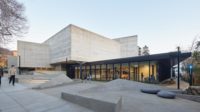Berkeley, California
When architect John Galen Howard mapped a Beaux-Arts plan for the University of California, Berkeley campus in the early 20th century, one of the first buildings erected in its spirit was Durant Hall—a two-story steel-framed structure completed in 1911 and wrapped in granite along classical lines. Designed by Howard for the law school, and later home to the university’s East Asian Library, the 18,000-square-foot box has been restored to house the administrative offices of the College of Letters and Sciences, which had been scattered among several locations. The building also has been brought discreetly into the 21st century, its formal aura softened by an emphasis on sustainability and a new entry plaza that invites students to linger.
“A straight restoration would have left it wooden, part of the past, but clumsy changes would have been criminal,” says Mark Cavagnero, a Bay Area architect best known for a refined but strong Modernist style. While this design philosophy might make his firm seem an odd choice for restoring Howard’s landmark, Cavagnero got his start in the office of Edward Larrabee Barnes, where he oversaw the restoration of San Francisco’s ornate California Palace of the Legion of Honor.
Except for common areas, most of Durant’s interior had been altered haphazardly over the decades, leaving little of historic value. The regal exterior was as evocative as ever, however. And that posed the first design challenge: circulation. The central corridor on the first floor was reached via stairs from landings on the north and south ends. Adding ramps or an exterior elevator would have upended the building’s classical symmetry, so Cavagnero looked to Durant’s western face, where a shallow slope and hedges masked the structure’s basement. With minimal excavation, the area was reborn as a terraced plaza approached from three directions—one approach is a gently sloped path that is inviting for pedestrians and people in wheelchairs.
The reoriented basement, which in its prior life was jammed with support-staff desks and storage areas, now has a quiet, open feel and includes a graduate research center. The look is contemporary and clean, with opaque glass panels covering the structural walls and a combination of frosted and clear glass for walls defining conference rooms and offices—all part of Cavagnero’s effort to bring as much light into the space as possible.
Cavagnero’s work in the first-floor corridor was closer to pure restoration. Here the utilitarian red rubber originally on the floor has been replicated; the plaster walls and vaulted ceiling have been patched; and the bronze chandeliers, which Howard designed and referred to as “lamps of learning,” have been refurbished to accommodate compact fluorescents.
The second floor is more assertive: Worn white marble stairs lead to an oak-paneled doorway and then the skylit central reading room accented with Doric columns of creamy yellow marble. It’s a compact but powerful space already popular for small talks and other events; during the day it serves as the reception area for the four deans’ offices that frame it.
But the project’s main goal was consolidation of administrative space, and that is what Cavagnero has done. The attic behind the pitched roof now contains staff cubicles, for instance, as do second-floor spaces once jammed with staff-only library shelves. This deft accommodation of old and new also includes discreet energy-efficiency upgrades such as new mechanical units tucked into original millwork. The strategy paid off: Earlier this year Durant earned a Silver rating from the U.S. Green Building Council, making it the first LEED-certified building on Berkeley’s central campus—evidence that there’s no inherent conflict between the needs of our future and the classical landscapes of our past.
John King is the Urban Design critic of the San Francisco Chronicle and author of Cityscapes: San Francisco and its buildings (Heyday 2011).
Total construction cost: $7.8 million
Completion Date: August 2010
Gross square footage: 18,000
Architect:
Mark Cavagnero Associates
1045 Sansome Street, Suite 200
San Francisco, CA 94111
T: 415-398-6944
F: 415-398-6943
PeopleOwner: University of California, Berkeley
Architect:
Personnel in architect's firm who should receive special credit:
Architect of record
Interior designer
Engineer(s) Structural: David Mar, SE, Principal, Tipping Mar Associates Mechanical & Plumbing: Daig O’Connell, Principal, Cammisa and Wipf Electrical: Robert Boyd, Principal, Cammisa & Wipf
Consultant(s) Lighting: Mary-Jane Lawless, Director, Silverman & Light Acoustical: Thomas Schindler, PE, Acoustic Designer, Charles M. Salter Associates
Other:
General contractor
Photographer(s)
CAD system, project management, or other software used |
Products
Structural system
Exterior cladding
Roofing
Windows
Glazing
Doors Metal doors: New storefront system by Acme. Wood doors: Restored historic wood doors.
Hardware Closers: LCN + Dorma, Norton Exit devices: Von Duprin Other special hardware: Historic hardware restored by Cirecast. Glass door hardware by Blumcraft.
Interior finishes Suspension grid: Armstrong, Eurospan, Decoustics Demountable partitions: Acme Paints and stains: Kelly Moore Wall coverings: Carnegie/Xorel, Walltalkers Paneling: Softwalls Solid surfacing: Corian Floor and wall tile: Crossville (at restrooms) Resilient flooring: Artigo rubber floors Carpet: Bentley Prince St Carpet
Furnishings Reception furniture: Coalesse, HBF Chairs: Steelcase, Coalesse Tables: Coalesse, Nienkamper Upholstery: Martin Braadtrud
Lighting Downlights: Louis Poulson, Artemide Task lighting: Gammalux Exterior: Hess, Besa
Conveyance
Plumbing Sinks and Faucets: Elkay Drinking Fountains: Oasis
Energy |










Post a comment to this article
Report Abusive Comment